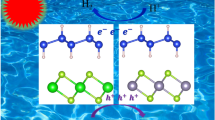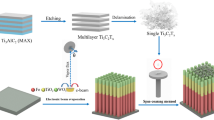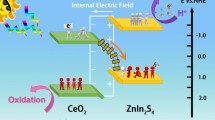Abstract
In the field of photocatalytic water splitting, the direct Z-scheme heterostructure is regarded as a promising photocatalyst configuration. In this paper, we use density functional theory to predict the Ti2CO2/CrSSe heterostructure as a potential direct Z-scheme heterojunction photocatalyst and investigate its electronic, optical, and heterojunction interface properties. The results show that the Ti2CO2/CrSSe heterojunction has a strong electrostatic attraction between the electrons in the conduction band of Ti2CO2 and the holes in the valence band of CrSSe due to the small interlayer band gap, which can realize the rapid interlayer electron-hole (e−–h+) recombination. The redistribution of charge results in a built-in electric field that prevents unwanted electron and hole migration. In addition, the Ti2CO2/CrSSe van der Waals (vdW) heterojunction exhibits excellent light absorption, and its redox ability has been improved. These properties indicate that Ti2CO2/CrSSe heterostructure is a promising photocatalyst.
Graphical Abstract








Similar content being viewed by others
References
Schultz DM, Yoon T (2014) Solar synthesis: prospects in visible light photocatalysis. Science 343(6174):1239176
Tachibana Y, Vayssieres L, Durrant JR (2012) Artificial photosynthesis for solar water-splitting. Nat Photon 6:511–518
Moniz SJA, Shevlin SA, Martin DJ, Guo Z-X, Tang J (2015) Visible-light driven heterojunction photocatalysts for water splitting—a critical review. Energy Environ Sci 8(3):731–759
Fujishima A, Honda K (1972) Electrochemical photolysis of water at a semiconductor electrode. Nature 238:37–38
Jiang C, Moniz SJA, Wang A, Zhang T, Tang J (2017) Photoelectrochemical devices for solar water splitting—materials and challenges. Chem Soc Rev 46:4645–4660
Schneider J, Matsuoka M, Takeuchi M, Zhang J, Horiuchi Y, Anpo M, Bahnemann DW (2014) Understanding TiO2 photocatalysis: mechanisms and materials. Chem Rev 114(19):9919–9986
Chen H, Wang L, Beilstein J (2014) Nanostructure sensitization of transition metal oxides for visible-light photocatalysis. Nanotechnology 5:696–710
Karunakaran C, Senthilvelan S (2005) Photocatalysis with ZrO2: oxidation of aniline. J Mol Catal A-chem 233(1–2):1–8
Luo B, Liu G, Wang L (2016) Recent advances in 2D materials for photocatalysis. Nanoscale 8:6904–6920
Yin WJ, Wei SH, Al-Jassim MM, Yan Y (2011) Double-hole-mediated coupling of dopants and its impact on band gap engineering in TiO2. Phys Rev Lett 106:66801
Novoselov KS, Geim AK, Morozov SV, Jiang D, ZhangY DSV, Grigorieva IV, Firsov AA (2004) Electric field effect in atomically thin carbon films. Science 306(5696):666–669
Xiao D, Liu G-B, Feng W, Xu X, Yao W (2012) Coupled spin and valley physics in monolayers of MoS2 and other group-VI dichalcogenides. Phys Rev Lett 108:196802
Frame F, Osterloh F (2010) CdSe-MoS2: a quantum size-confined photocatalyst for hydrogen evolution from water under visible light. J Phys Chem C 114(23):10628–10633
Su T, Shao Q, Qin Z, Guo Z, Wu Z (2018) Role of interfaces in two-dimensional photocatalyst for water splitting. ACS Catal 8(3):2253–2276
Ma X, Wu X, Wang H, Wang Y (2018) A Janus MoSSe monolayer: a potential wide solar-spectrum water-splitting photocatalyst with a low carrier recombination rate. J Mater Chem A 6:2295–2301
Lu A-Y, Zhu H, Xiao J, Chuu C-P, Han Y, Chiu M-H, Cheng C-C, Yang C-W, Wei K-H, Yang Y, Wang Y, Sokaras D, Nordlund D, Yang P, Muller DA, Chou M-Y, Zhang X, Li L-J (2017) Janus monolayers of transition metal dichalcogenides. Nat Nanotechnol 12:744–749
Hoffmann MR, Martin ST, Choi W, Bahnemann DW (1995) Environmental applications of semiconductor photocatalysis. Chem Rev 95(1):69–96
Gu W, Lu F, Wang C, Kuga S, Wu L, Huang Y, Wu M (2017) Face-to-face interfacial assembly of ultrathin g-C3N4 and anatase TiO2 nanosheets for enhanced solar photocatalytic activity. ACS Appl Mater Interfaces 9(34):28674–28684
Lin B, Li H, An H, Hao W, Wei J, Dai Y, Ma C, Yang G (2018) Preparation of 2D/2D g-C3N4 nanosheet@ZnIn2S4 nanoleaf heterojunctions with well-designed high-speed charge transfer nanochannels towards high-efficiency photocatalytic hydrogen evolution. Appl Catal B 220:542–552
Wu H, Meng S, Zhang J, Zheng X, Wang Y, Chen S, Qi G, Fu X (2020) Preparation of 2D/2D g-C3N4 nanosheet@ZnIn2S4 nanoleaf heterojunctions with well-designed high-speed charge transfer nanochannels towards high-efficiency photocatalytic hydrogen evolution. Appl Surf Sci 505:144638
Zhao P, Liang Y, Ma Y, Huang B, Dai Y (2019) Janus chromium dichalcogenide monolayers with low carrier recombination for photocatalytic overall water-splitting under infrared light. J Phys Chem C 123(7):4186–4192
Wang J, Rehman SU, Tariq Z, Zhang X, Zheng J, Butt FK, Li C (2021) Pristine and Janus chromium dichalcogenides: potential photocatalysts for overall water splitting in wide solar spectrum under strain and electric field. Sol Energy Mater Sol Cells 230:111258
Li X, Yu J, Jaroniec M (2016) Hierarchical photocatalysts. Chem Soc Rev 45:2603–2636
Yuan Y-P, Ruan L-W, Barber J, Loo SCJ, Xue C (2014) Hetero-nanostructured suspended photocatalysts for solar-to-fuel conversion. Energy Environ Sci 7:3934–3951
Chen S, Hu Y, Ji L, Jiang X, Fu X (2014) Preparation and characterization of direct Z-scheme photocatalyst Bi2O3/NaNbO3 and its reaction mechanism. Appl Surf Sci 292:357–366
Zhang JF, Hu YF, Jiang XL, Chen SF, Meng SG, Fu XL (2014) Design of a direct Z-scheme photocatalyst: preparation and characterization of Bi2O3/g-C3N4 with high visible light activity. J Hazard Mater 280:713–722
Meng S, Sun W, Zhang S, Zheng X, Fu X, Chen S (2018) Insight into the transfer mechanism of photogenerated carriers for WO3/TiO2 heterojunction photocatalysts: is it the transfer of band-band or Z-scheme? Why? J Phys Chem C 122(46):26326–26336
Meng S, Chen C, Gu X, Wu H, Meng Q, Zhang J, Chen S, Fu X, Liu D, Lei W (2021) Efficient photocatalytic H2 evolution, CO2 reduction and N2 fixation coupled with organic synthesis by cocatalyst and vacancies engineering. Appl Catal B 285:119789
Kohn W, Sham LJ (1965) Self-consistent equations including exchange and correlation effects. Phys Rev 140(4A):A1133
Kresse G, Furthmüller J (1996) Efficiency of ab-initio total energy calculations for metals and semiconductors using a plane-wave basis set. Comput Mater Sci 6(1):15–50
Perdew JP, Wang Y (1992) Accurate and simple analytic representation of the electron-gas correlation energy. Phys Rev B 45(23):13244
Perdew JP, Burke K, Ernzerhof M (1996) Generalized gradient approximation made simple. Phys Rev Lett 77(18):3865
Grimme S, Antony J, Ehrlich S, Krieg H (2010) A consistent and accurate ab initio parametrization of density functional dispersion correction (DFT-D) for the 94 elements H-Pu. J Chem Phys 132(15):154104
Tran F, Blaha P (2009) Accurate band gaps of semiconductors and insulators with a semilocal exchange-correlation potential. Phys Rev Lett 102(22):226401
Heyd J, Scuseria GE, Ernzerhof M (2003) Hybrid functionals based on a screened coulomb potential. J Chem Phys 118(18):8207
Wang V, Xu N, Liu J-C, Tang G, Geng WT (2019) VASPKIT: a pre- and post-processing program for VASP code. arXiv1908:08269.
Fu CF, Li X, Yang J (2021) A rationally designed two-dimensional MoSe2/Ti2CO2 heterojunction for photocatalytic overall water splitting: simultaneously suppressing electron-hole recombination and photocorrosion. Chem Sci 12:2863–2869
Djire A, Wang X, Xiao C, Nwamba OC, Mirkin MV, Neale NR (2020) Nitride MXenes: basal plane hydrogen evolution activity from mixed metal nitride MXenes measured by scanning electrochemical microscopy. Adv Funct Mater 30(47):2070313
Heyd J, Peralta JE, Scuseriaet GE (2005) Energy band gaps and lattice parameters evaluated with the Heyd-Scuseria-Ernzerhof screened hybrid functional. J Chem Phys 123(17):174101
Xu L, Huang W-Q, Wang L-L, Huang G-F, Peng P (2014) Mechanism of superior visible-light photocatalytic activity and stability of hybrid Ag3PO4/graphene nanocomposite. J Phys Chem C 118(24):12972–12979
Low J, Jiang C, Cheng B, Wageh S, Al-Ghamdi AA, Yu J (2017) A review of direct Z-scheme photocatalysts. Small Methods 1(5):1700080
Zhou Z, Niu X, Zhang Y, Wang J (2019) Janus MoSSe/WSeTe heterostructures: a direct Z-scheme photocatalyst for hydrogen evolution. J Mater Chem A 7:21835–21842
Acknowledgements
This work was supported by the Technology Coordination Innovation Project of Shaanxi province under Grant (No. S2018-ZC-PT-0024).
Author information
Authors and Affiliations
Corresponding author
Ethics declarations
Conflict of interest
The authors declare no competing financial interest.
Additional information
Publisher's Note
Springer Nature remains neutral with regard to jurisdictional claims in published maps and institutional affiliations.
Rights and permissions
About this article
Cite this article
Cao, J., Zhang, X., Zhao, S. et al. Two-Dimensional Ti2CO2/CrSSe Heterostructure as a Direct Z-Scheme Photocatalyst for Water Splitting. Catal Lett 152, 2564–2574 (2022). https://doi.org/10.1007/s10562-021-03842-y
Received:
Accepted:
Published:
Issue Date:
DOI: https://doi.org/10.1007/s10562-021-03842-y




